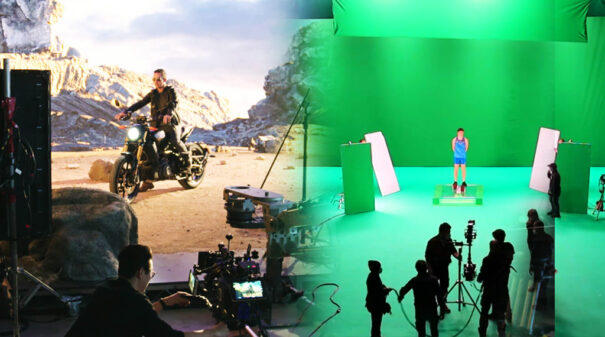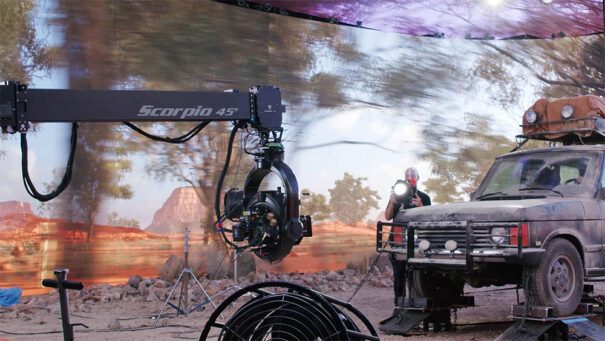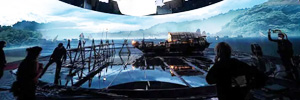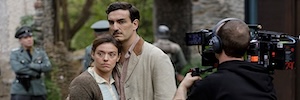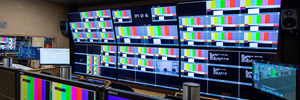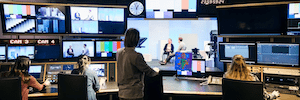Producción virtual vs. croma: ¿solo puede quedar uno?
En esta Tribuna, David I. García, CEO, y Raquel Esteban, productora ejecutiva, ambos parte de la empresa zaragozana especializada en producción virtual y realidad extendida Magic Fennec, analizan la pervivencia de las producciones basadas en croma frente a los nuevos estudios de producción virtual, destacando los beneficios de cada una de sus propuestas y asomándose al futuro de la producción audiovisual.
The producción virtual basada en pantallas LED ha llegado para ayudar a evolucionar la industria. Más allá de las posibilidades multiusuario y la edición en tiempo real, que permiten tomar decisiones certeras y rápidas en el momento de la producción y dan múltiples posibilidades a los realizadores y directores de fotografía, esta tecnología se caracteriza por la capacidad de operar en dos modos: plates o parallax. Si bien, la primera opción podría ser una evolución de la clásica retroproyección, la segunda pasa a posibilitar el tracking de cámara y la exploración de un entorno 3D basado en un motor en tiempo real, lo que puede marcar una verdadera diferencia.
La combinación de estas técnicas aporta muchas posibilidades a las producciones, pero no vale para todo: dependerá de cada producción su uso o no. Por ejemplo, es muy recomendable para escenas en las que entren en juego reflejos, como las protagonizadas por vehículos. Por ejemplo, desde Magic Fennec estuvimos trabajando en Berlín (Vancouver Media, Netflix) y el equipo de producción había planificado una escena que podría conllevar cierto riesgo. Para no exponer al talento a ese proceso, decidieron rodar esos primeros planos en producción virtual prescindiendo de plates para apostar por el parallax.
Esta tecnología también marca una diferencia significativa en escenarios que presentan riesgos o que suelen estar sobrepoblados. Permite simular estos entornos sin necesidad de trasladar al equipo de producción al lugar, contribuyendo a la reducción del impacto ambiental. Además, facilita una gestión completa sobre las condiciones meteorológicas y de iluminación: desde simular el amanecer hasta recrear condiciones climáticas específicas como lluvia o nieve, eliminando la presión de trabajar contra el reloj. Si se requiere capturar una escena específica bajo la luz del atardecer durante 12 horas, es completamente factible. Esta flexibilidad se extiende a la generación de multitudes o la creación de escenarios complejos.
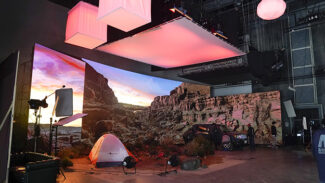 La industria del cine y la tele, “culpables” de la producción virtual
La industria del cine y la tele, “culpables” de la producción virtual
La producción virtual es el cambio realmente transformador del siglo XXI en lo relativo al audiovisual. No consideramos que rompa la magia del cine, sino que la complementa aportando alternativas y opciones para dar más posibilidades que la que podrían tener en determinados contextos en exteriores. La propia técnica sigue rompiendo esquemas: cada día hay algo nuevo que nos hace subir un peldaño más. ¿Y dónde va a acabar? Sinceramente, esperamos con ansias saberlo.
Por ejemplo, hace seis meses salió una nueva actualización de Unreal Engine (motor que utilizamos en Magic Fennec) que nos permite controlar elementos de la iluminación de los entornos virtuales directamente desde una aplicación para una tableta. Otras mejoras recientes son las light cards de los estudios virtuales. Son elementos geométricos que pueden ser mandados a la pantalla directamente para así iluminar la escena, permitiendo afinar cada aspecto de la iluminación de la escena.
La producción virtual es el cambio realmente transformador del siglo XXI en lo relativo al audiovisual. No consideramos que rompa la magia del cine, sino que la complementa aportando alternativas.
Las producciones virtuales han llegado para quedarse. Podemos decir que existe una garantía de evolución materializada por las compañías de la industria. Los propios Disney y Sony, dos de los más grandes promotores del sector audiovisual, han invertido en Epic Games (casa desarrolladora de Unreal Engine), para potenciar este entorno. Sony compró Pixomondo, una de las mayores empresas especializadas en la producción con pantallas LED y Disney sigue trabajando en explorar todas las posibilidades de este sistema a través de Epic y su desarrollo StageCraft sumando tecnología de Industrial Light and Magic.
En la actualidad, podemos hablar de que existe una línea directa para que estos agentes decidan dónde quieren ir evolucionando, lo cual es maravilloso. La tecnología se seguirá desarrollando y, eventualmente, llegará al resto de personas que trabajamos con ella.
 La pantalla verde en un mundo de producción virtual
La pantalla verde en un mundo de producción virtual
Frente a una producción virtual ICVFX con muros LED que sigue avanzando a gran ritmo, el croma (o las pantallas verdes) han ralentizado su utilización. Hoy, ofrecen en términos generales tres modelos de trabajo que complementan los procesos de producción y postproducción.
El primero es el estándar, el típico que conocemos. Grabamos en croma y mantenemos los puntos de referencia para luego pasar a postproducción. El proceso no ha evolucionado tanto, pero el flujo se mantiene. El segundo cambia con la introducción del simulcam, o cámara simulada. Con esta técnica basada en tracking, los equipos de realización y producción pueden ver una vista preliminar (que tendrá que ser finalizada en postproducción) del resultado final. De esta forma, el director puede elegir mejor las tomas y gestionar mejor el talento, o el director de fotografía puede ser capaz de controlar mejor la iluminación. También sirve para que el cliente en el proceso de rodaje de un anuncio pueda tomar decisiones en tiempo real, pudiendo hilar con gran detalle, conseguir el resultado que esperaba e incluso tener una primera composición previa en 24h.
El tercer uso, que hemos aplicado en algunos procesos broadcast as Mapi, es la aplicación de estas técnicas en tiempo real, con elementos como realidad aumentada o sets extendidos. Hay muchos ejemplos en este sentido, pero la realidad es que todavía estamos muy limitados por el rendimiento de la tecnología. Por ejemplo, los efectos y las transparencias siguen siendo elementos muy costosos de renderizar en tiempo real.
¿La producción virtual sustituirá a los cromas?
Ante la estabilidad de los cromas, y la efervescencia de la producción virtual, se podría pensar que una sustituirá a la otra. Sin embargo, nosotros pensamos que la postproducción con croma y la virtual production tienen que ir de la mano y van a convivir al 100%. En ocasiones lo hacen inclusive en el mismo plano donde el inner frustum, o en otras palabras lo que graba la cámara, es un fondo verde y el outer frustum, el resto de la pantalla, es el escenario 3D que estaría generando reflejos dinámicos, iluminando la escena y ahorrando gran parte de la posproducción.
Para España, aunque el croma es un viejo conocido, la producción virtual todavía es algo nuevo y eso conlleva un desconocimiento sobre sus limitaciones y su uso. Pero el futuro ya es presente, si queremos verlo desde nuestro país hay que asomarse al océano y ver qué está pasando, es conveniente perder el miedo.
Ante la estabilidad de los cromas, y la efervescencia de la producción virtual, se podría pensar que una sustituirá a la otra. Sin embargo, nosotros pensamos que la postproducción con croma y la virtual production tienen que ir de la mano y van a convivir al 100%
La gran evolución que marcará el despliegue de la virtual production no dependerá de la tecnología, sino que será una cuestión de pensamiento. Es necesario entender todas las posibilidades pueden dar estas herramientas y que esto se vea reflejado en los guiones y en los equipos de producción. Por supuesto que los motores a tiempo real seguirán mejorando y tendremos un mejor hardware, permitiendo mayor rendimiento y mejor control de color, o un mejor software de calibración que dé más fidelidad visual. Pero tan solo invirtiendo en personas que realmente sepan de virtual production, y trasladando esta filosofía a todos los equipos de producción, podremos ir mejorando. Es como cualquier tipo de profesión: cuanto más haces, mejor eres.
La eficacia y rentabilidad de la producción virtual en España, así como el uso del croma cuando sea necesario, reside en la integración inteligente y creativa de estos recursos según las necesidades específicas de cada proyecto. La decisión de cuándo y cómo utilizar la producción virtual o el croma debería basarse en una evaluación detallada de los objetivos artísticos y logísticos, así como en el impacto que estas tecnologías pueden tener en la narrativa, la autenticidad visual y la eficiencia de la producción.
Lo fundamental es considerar cómo estas herramientas pueden aportar valor agregado a la producción, ya sea mejorando la calidad visual, reduciendo costos de desplazamiento y logística, o permitiendo una mayor flexibilidad en la postproducción. La inversión en producción virtual y croma se justifica plenamente cuando su aplicación está alineada con una visión estratégica que busca optimizar recursos, potenciar la creatividad y superar las limitaciones tradicionales de la producción.
David I. García, CEO, y Raquel Esteban, productora ejecutiva
Magic Fennec
Did you like this article?
Subscribe to our NEWSLETTER and you won't miss anything.



